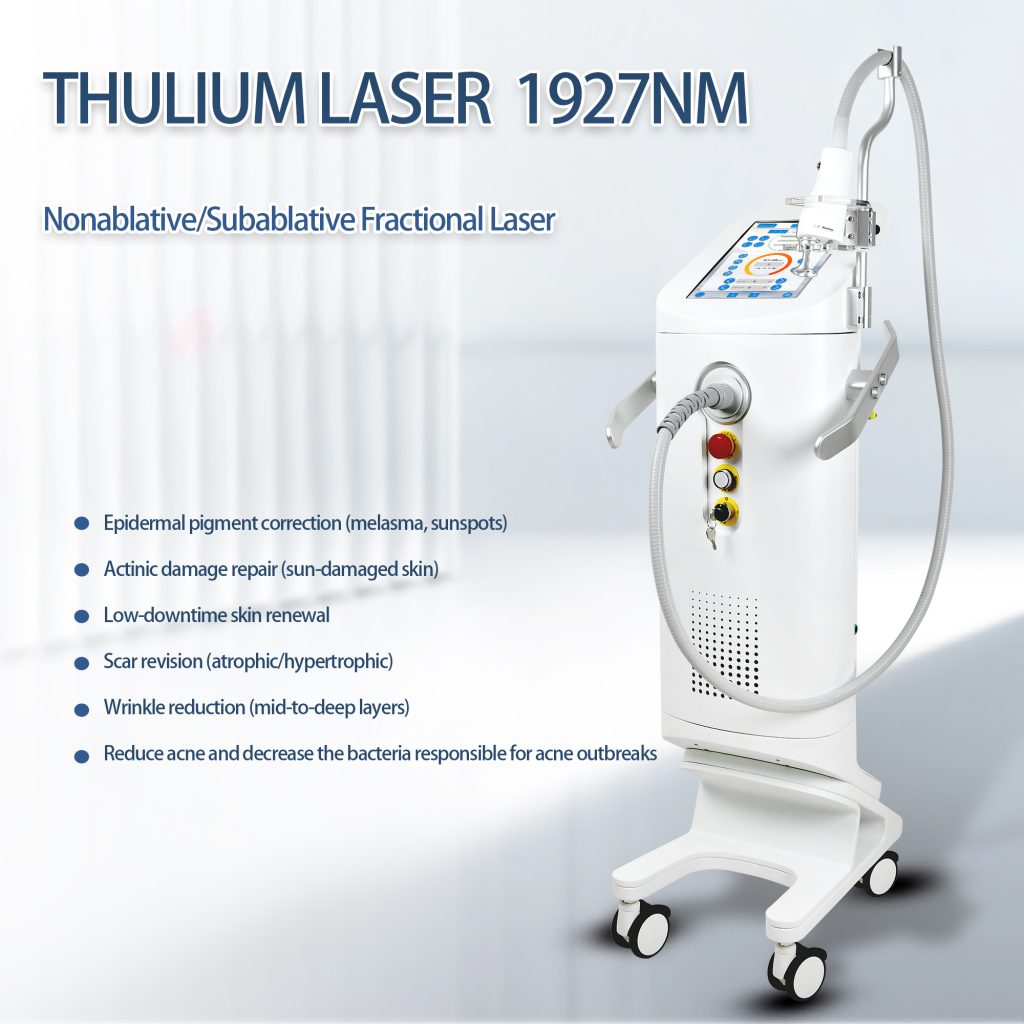EMS Pelvic Chair Machine: A Revolutionary Solution for Urinary Incontinence through Pelvic Floor Muscle Enhancement
December 24, 2025The Effectiveness of the 1927nm Thulium Laser in Modern Medical Applications
April 25,2025
Introduction
Laser technology has revolutionized medical and aesthetic treatments, offering precision and reduced recovery times. Among the advancements, the 1927nm Thulium laser has emerged as a versatile tool, particularly in dermatology. This article explores its mechanism, applications, clinical effectiveness, and comparative advantages, underscoring why it has become a preferred choice for many practitioners and patients.

Mechanism of Action
The 1927nm Thulium laser operates at a wavelength highly absorbed by water in biological tissues. This absorption generates controlled thermal energy, targeting the epidermis and upper dermis without extensive collateral damage. Unlike ablative lasers that vaporize tissue, the 1927nm Thulium laser often employs a fractional approach, treating microscopic zones of the skin. This method stimulates collagen production and cellular renewal while preserving surrounding tissue, facilitating faster healing.
Applications in Dermatology
- Skin Resurfacing and Rejuvenation
The laser effectively addresses fine lines, wrinkles, and uneven texture by promoting collagen remodeling. Studies show that fractional Thulium treatments yield significant improvements in skin elasticity and tone, with patients noting a “refreshed” appearance after 1–3 sessions. - Acne Scar Treatment
Acne scars, particularly atrophic types, respond well to the 1927nm wavelength. A 2018 study in JAMA Dermatology highlighted a 40–60% improvement in scar depth after three sessions, attributed to dermal collagen synthesis. The fractional method ensures deeper scars are gradually smoothed without excessive downtime. - Pigmentation Disorders
Melasma and sun-induced hyperpigmentation are mitigated through the laser’s ability to target melanin-rich cells. Research in Lasers in Surgery and Medicine demonstrated a 70% reduction in pigmentation in Fitzpatrick skin types III–IV after four treatments, emphasizing its efficacy in moderate cases. - Vascular Lesions
While less common, the Thulium laser can coagulate superficial blood vessels, reducing redness from rosacea or telangiectasias. Its precision minimizes damage to surrounding vasculature, offering a safer profile for sensitive areas.
Clinical Effectiveness and Supporting Evidence
Multiple clinical trials validate the 1927nm Thulium laser’s efficacy. A 2020 meta-analysis in Aesthetic Plastic Surgery concluded that it achieves comparable results to CO2 lasers for moderate skin damage but with fewer side effects. Patients typically report high satisfaction rates, citing minimal discomfort and rapid recovery.

Comparison with Other Lasers
- CO2 Lasers (10,600nm): More aggressive, ideal for severe wrinkles but require 2–3 weeks of downtime. Higher risk of hypopigmentation and scarring.
- Erbium:YAG (2940nm): Superficial penetration, suited for mild resurfacing with almost no downtime but limited collagen stimulation.
- 1927nm Thulium: Balances efficacy and safety, offering moderate penetration with a 3–5 day recovery. Ideal for patients seeking noticeable results without prolonged downtime.
Safety and Side Effects
Common side effects include transient erythema and edema, resolving within days. Hyperpigmentation risk, though lower than CO2, necessitates caution in darker skin types (Fitzpatrick IV–VI). Studies note a <5% complication rate when protocols are followed, emphasizing its safety in experienced hands.
Patient Considerations
The Thulium laser suits individuals with mild-to-moderate photodamage, seeking subtle yet cumulative improvements. Ideal candidates have realistic expectations and commit to 3–5 sessions spaced 4–6 weeks apart. Pre-treatment consultations should address skin type, medical history, and sun exposure to optimize outcomes.
Conclusion
The 1927nm Thulium laser stands out for its balanced approach to skin rejuvenation, merging efficacy with safety. Its fractional technology, shorter recovery, and adaptability across skin types make it a cornerstone in modern dermatology. As research evolves, its role in minimally invasive treatments is poised to expand, solidifying its status as a transformative tool in aesthetic medicine.
By prioritizing patient-centered outcomes and leveraging advanced laser mechanics, the 1927nm Thulium laser exemplifies the synergy between innovation and clinical practicality, offering a compelling option for those navigating the landscape of skin revitalization.